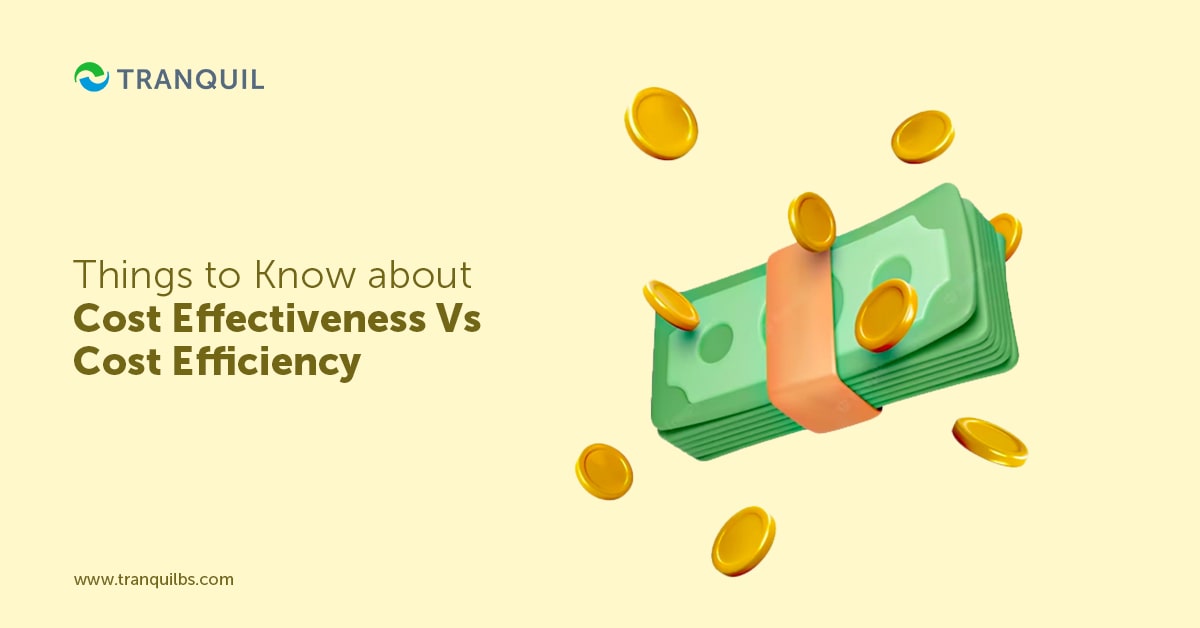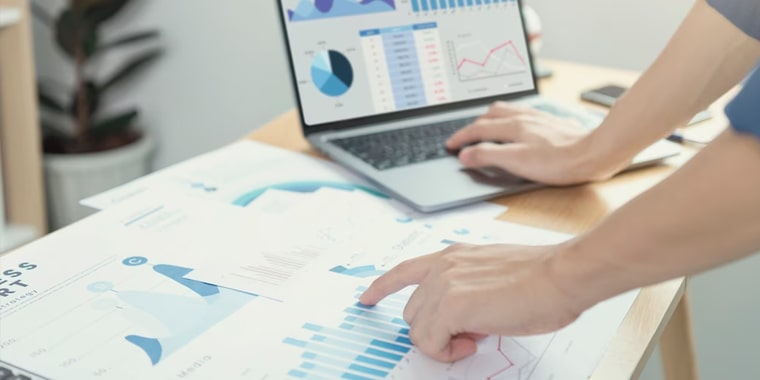
Money drives business and hence, every business, whether a small startup or established multinational, constantly looks for ways to save money, or to use the funds in a more productive way – that is, to make more money!
When talking about saving costs, there are two terms that we often hear people use: cost-effectiveness and cost-efficiency.
But the two words though similar sounding, are different.
Let us look what cost effectiveness vs cost efficiency is and what it entails.
Hopefully, by the end of this article, you will know to differentiate between these two important terms, and know how to achieve both for the benefit of your business.
ALSO READ: Cost Reduction Strategies in Procurement
Cost-effectiveness focuses on enhancement of spend rather than spending funds on expensive solutions that does not deliver significant benefits.
Cost-efficiency refers to the capability of businesses to cut costs and increase productivity, and earn more profits than competing businesses with access to similar resources.
Being cost-effective focuses on doing the right things whereas being cost-efficient focuses on doing things the right way.

To put it in simple words, to be cost-effective means to minimize your expenses and maximize your profitability.
It is about looking for the best ways to spend money to get the most benefit rather than spend your funds on an expensive solution that delivers little or no benefits.
ALSO READ: Benefits of Warehouse Management System
Being cost-effective allows companies to earn maximum profits by keeping costs to a minimum.
Companies can also measure how well they are able to achieve their business objectives by being cost-effective.
Cost-effectiveness allows you to know the right measure to take for your business for steady and rapid growth.
Being cost-effective is essential for any business to grow.

Cost-efficiency is also very important for any business; while it can mean several things depending on the context, there is one major thing it does refer to regardless of type or size of business.
That is the capability of the business to cut their costs, boost productivity, and churn out greater profits than competing businesses who have more or less the same resources and incur similar expenses.
A business that practices cost-efficiency is capable of delivery superior services to its customers, while preventing overspending and attaining higher profit margins.
To put it in simple words, for a business to be cost-efficient means how it can deliver products and services at the least possible cost with zero compromise on quality.
ALSO READ: Detailed Guide on ROI on ERP Implementation
It is all about saving on expenses while at the same time maintaining a high standard of product quality, service, innovation, and so on.
Being cost-effective is not the same as cutting costs; cost-cutting is all about saving money without considering the effects on the business in the long run.
Being cost-efficient can help your business to save money without negatively impacting your products or services that you deliver to your customers.
By being cost-efficient, companies can become more profitable, and become capable of making more informed decisions.
This is achieved through a thorough evaluation of costs, benefits, and value of investments, and it can also help in discovering opportunities that you may have overlooked otherwise.
Companies can maximize their potential when they are cost efficient, and can prevent stretching themselves too thin financially.
This is especially important for small businesses who are yet to accumulate abundant resources.
ALSO READ: Different Ways to Improve the Procurement Process

As we discussed above, both cost-effectiveness and cost-efficiency are two commonly used words in business that are often erroneously used in place of each other, though they mean different things.
You measure cost-effectiveness to determine how well your business has achieved its goals; basically, it is the relationship between how many resources you utilize to achieve the results you have.
Whereas, cost-efficiency talks about the methods by which a business uses the least resources or incurs the lowest cost in completing a project or delivering goods and services to the customer, without compromising on the promised quality standards.
To put it in another way, when a business is cost-effective, we can say that it is doing the right things.
When a business is cos-efficient, we can say that it is doing things the right way.
ALSO READ: Understanding the Importance of Distribution Management

Now that we have seen what cost-effectiveness is, let us look at the ways to be more cost-effective.
It is imperative that there is a system that allows companies to study and implement strategies to save on expenses.
Without having visibility into all of the spending of your whole company, it will be nearly impossible to employ a strategy that allows you to be cost effective.
Implementing a system to manage costs optimizes your supply chain, reducing your expenses via domestic purchasing and other strategies.
ALSO READ: Challenges and Opportunities of AI in Procurement
Around the world, businesses that deal in products have to spend a huge amount on inventory.
However, you can reduce your spending if you manage your inventory properly.
Tranquil inventory management system can help you do just that.
By controlling the inventory effectively, you can minimize your total spend by monitoring and handling sudden flareups in variable costs that can occur when you carry inventory for a longer period.
ALSO READ: MRO Inventory and Its Importance
When you build and implement a robust IT infrastructure, you can minimize outages and downtime, and significantly bring down failure in business operations.
By moving to cloud IT infrastructure, you can substantially reduce expenses of maintaining the system, and even make it simple and smooth to manage.
The initial financial outlay may be large, however, you will realize that automating systems delivers immense benefits in both the short term as well as the long term for your company.
ALSO READ: What is Economic order Quantity?

We’ve seen above how a business can improve cost-effectiveness, now let us understand how to be more cost-efficient.
A cost benefit analysis will allow your company to assess the economic value of undertaking a specific project.
It is valuable for businesses who want to become cost-efficient as it studies if a specific project delivers benefits that outweighs the expenses.
A cost benefit analysis gives businesses a basis for comparing projects, and it is also a systematic method of arriving at the most cost-efficient path to the desired results of that business.
ALSO READ: Benefits and Steps of SKU Rationalization
In business, we believe that what you cannot measure cannot be managed.
While it seems obvious, unfortunately, many companies seem to overlook the fact that costs can be managed much better when you set a budget for the project.
The work you outsource, or employees you hire for a project, while being your biggest assets, are also going to be your biggest cost.
It is therefore essential that you know the path of your project, calculate costs accurately, and allocate resources properly.
In fact, it is one of the most critical elements of project accounting.
When you have a realistic budget in place, you are well-equipped to deal with how to manage expenses for maximum efficiency and also search for methods to save money without compromising on the quality of your services or the project’s outcome for your customers.
ALSO READ: How ERP Can Improve Business Efficiency?
The most valuable metric that a business can employ to evaluate its status is revenue growth; it is the most strategic path to profitability in the long run.
The formula for revenue growth is used to arrive at the revenue your company earns in a specific period, and then comparing it with the revenue earned in previous time.
For example: profits from this quarter can be compared against the last quarter, or from the current financial year to the previous financial year, and so on.
Revenue growth goes beyond saving costs and sales as a shortcut to profitability.
It focuses on building accountability across the organization and includes strategies for marketing and pricing, human resources, and project management.
ALSO READ: Benefits of Implementing ERP in Banking Industry
We briefly touched upon cost benefit analysis as a method to improve cost efficiency.
Let us take a closer look at it.
A cost benefit analysis can help a business to strike a proper balance between becoming cost-effective and cost-efficient.
It is a methodical process of reviewing used by companies which assesses the decisions about what to let go of and what to retain.
The analyst conducting the cost benefit study makes a summary of the potential outcomes or rewards expected from a specific situation, and from it, reduces the total expenses associated with performing that action.
Some analysts are also called in to create models to assign monetary values to intangible items like costs and benefits associated with living in certain cities.
For example, accommodation could be hugely expensive in city A but jobs may be many, and salaries high – with readily available public transport.
In this case, the benefits are likely to outweigh the costs.
ALSO READ: What is Goods Received Note (GRN)?
A cost benefit analysis includes financial metrics like money saved or earned because of decisions to undertake specific projects.
It may also include intangible benefits, costs, or impacts as a result of the decision – for example, employee morale, customer satisfaction, goodwill, loss of reputation, etc.
Eventually, the outcome of the analysis is used to verify if it will be financially feasible to take up a certain project, or the company should not pursue it due to lack of benefits.
The cost benefit analysis often considers the element of opportunity costs; the opportunity cost offers the alternative benefits that could have been realized if a specific alternative had been chosen in the place of the one chosen now; it is the opportunity you missed or had to forego due to choosing this specific opportunity.
This enables project managers to measure the benefits from the alternatives rather than only concentrating on the current choice and its benefits.
As the cost benefit analysis considers multiple options and the potential missed opportunities, it is a thorough process that enables more informed decision making.
ALSO READ: ERP vs CRM
Keeping track of all expenses related to inventory, procurement, HR, and operations can be extremely daunting if done manually or when you use disparate systems.
You are likely to have errors, redundant or duplicated data, and other issues.
A cloud-based solution like Tranquil ERP offers a unified solution that will help you be both cost effective and cost efficient. Schedule a FREE demo to know more!